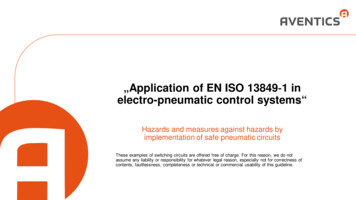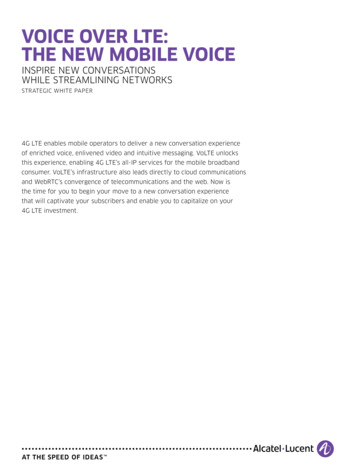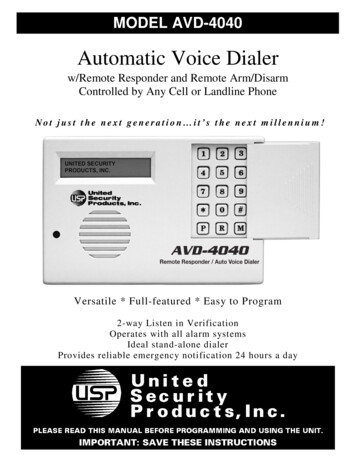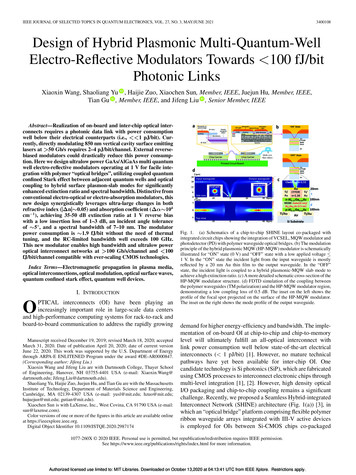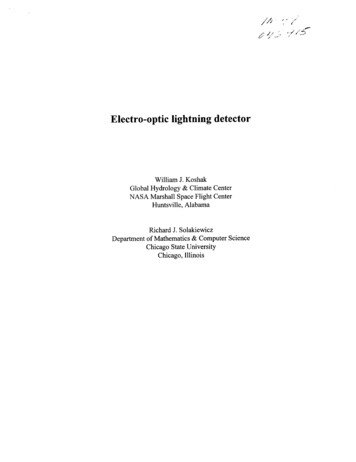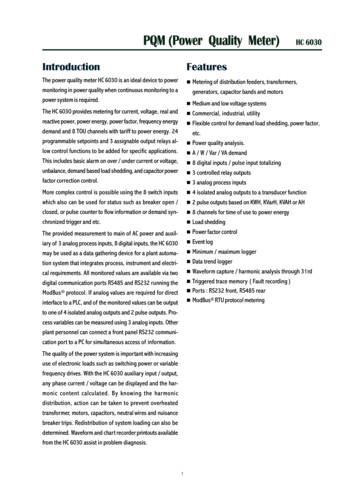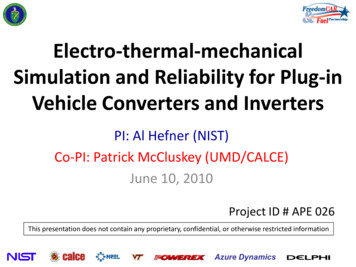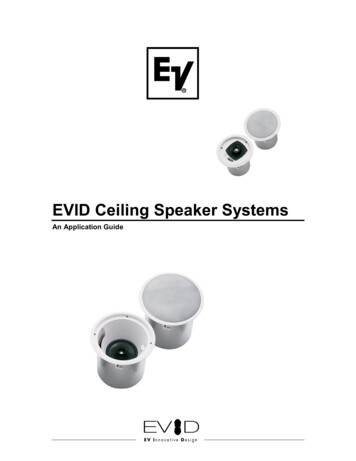
Transcription
EVID Ceiling Speaker SystemsAn Application Guide
THE CEILING SPEAKER SYSTEMS – AN OVERVIEW. 3VALUE OF PREMIUM PERFORMANCE:. 3A Unique Solution to an Age Old Problem . 3THE EVID SOLUTION – WHY IS IT DIFFERENT? . 3The EVID C8.2HC – Wide spectrum Pattern Control in a Compact Package. 3The EVID 4.2 and 8.2 – Full Range Models with Punch. 4The 10.1 - Finally a Compact True Ceiling Subwoofer. 4THE BASICS. 4SELECTING & POSITIONING CEILING LOUDSPEAKERS . 4Ceiling Systems – Size vs. Coverage. 5SPL Requirements – How Loud? . 6Layout – How Many?. 6THE “HIGH CEILING” SOLUTION - A REPLACEMENT FOR THE 920-8B . 6FAQ’S FOR EVID CEILING SYSTEMS . 7SYSTEM DESIGN QUESTIONS. 7Can I paint the EVID speakers to match the environment?. 7What finishes are the EVID models available in? . 7The installation requires no logo is visible on the speaker. What can I do? . 7Can I use the EVID C10.1 outdoors? . 7Can I use the C10.1ceiling subwoofer with an external crossover and separatepower amp channel? . 7What general guidelines do I consider when deciding on the physical placement ofthe EVID C10.1 ceiling subwoofer? . 7What typical subwoofer/satellite system configurations are possible? . 8How large an area can an EVID ceiling system cover? . 8What are some techniques to properly balance the levels between the subwoofer andsatellites? . 8SPECIFICATION QUESTIONS . 8Are the EVID ceiling speakers protected against excessive input power? . 8What are the characteristics of the matching transformers in the EVID models? . 8Do the EVID ceiling speakers work with both 70v and 100v systems? . 9What are the power taps for the various EVID “t” models”? . 9What equalization should I use for EVID ceiling systems? . 9EVID CEILING SPEAKER SYSTEM DESIGNS . 9What are some typical systems designs incorporating EVID series speakers?. 9SYSTEM DESIGN EXAMPLES . 10SMALL BAR OR RESTAURANT . 10DOCTORS OFFICE . 10LARGE RETAIL STORE. 11SHOPPING MALL . 11
The Ceiling Speaker Systems – An OverviewThe EVID ceiling system product line provides premium-level performance at a valueprice. Their wide coverage and high SPL capability allows the use of fewer speakers,resulting in lower system cost than the tight-spaced layout that low power narrowcoverage speakers require. The overall price differential of the EVID units to commoditytype speakers is actually quite small when the assembly and component costs of thesestandard ceiling speakers is taken into consideration. The EVID units are fully assembledand no additional installation components are generally needed. An EVID system “paysfor itself” very quickly. Locations with the highest sales per square foot are the ones whoare most careful about sound quality, music programming, and customer satisfaction.VALUE OF PREMIUM PERFORMANCE:People are getting used to better quality sound in their homes, cars and entertainmentspaces. Their expectations have grown for better quality sound in retail, office and otherbackground music spaces. Using premium quality audio systems can help increase salesthrough improved customer perceptions of the business’s products or services. It hasnow been well established that the quality of music in commercial spaces greatly impactsthe customer’s perceptions of the products or services of the establishment. The dollarpayback is substantial. High quality music also increases the friendliness and jobsatisfaction of the employees.A Unique Solution to an Age Old ProblemHigh ceilings and reverberant rooms have long been the downfall of many ceiling baseddistributed sound installations. The inherent desire for wide dispersion in smalleracoustically dead spaces works against the use of ceiling speakers in larger rooms withreverberant characteristics and higher ceilings. Until now there has not been a costeffective solution that combines good quality full range audio with useful pattern control.Some ceiling products attempted to have pattern control at the high frequencies but thisproved largely ineffective at the critical voice spectrum of the audio range. The resultwas a speaker that had the same poor intelligibility problems when used in reverberantroom as conventional ceiling speakers.The real solution to the problem requires that directionality must exist for the critical midfrequencies as well as the upper end of the spectrum. For this to happen a new approachis needed.The EVID Solution – Why is it Different?The EVID C8.2HC – Wide spectrum Pattern Control in a CompactPackageThe EVID C8.2HC is designed to provide directionality through the critical voicespectrum by employing a unique (patent pending) ported waveguide to the entire 8”driver. The resultant package is one that is compact, easy to install and provides far moreintelligibility in reverberant or high ceiling environments than any other competitivemodel. The C8.2HC also is designed for higher power, high SPL applications with a
60watt 70/100v transformer standard. No other ceiling speaker available offers thisunique solution.The EVID 4.2 and 8.2 – Full Range Models with PunchThe EVID C4.2 Perfect for conventional rooms. It has excellent bandwidth in anesthetically very unobtrusive installation profile. It’s compact design fits in tight areas.Fully rated for use in air handling spaces. It’s 4” woofer and waveguide coupled titaniumcoated dome tweeter give smooth, wide frequency response. The enclosure is ported andtuned to provide surprising bass response in such a compact package. Features an easy 3point mounting system for quick installations. Comes complete with mounting supportring and tile rails. No additional accessories needed for most installations.The C4.2 would be ideal for most office spaces along with smaller restaurants and retailspace where lower volume levels are used. It fits in close spaces and has a wide 130degree dispersion pattern for efficient coverage.The EVID C8.2 is also unique in providing extremely high fidelity in a flush mountceiling speaker. The secret is the optimally tuned enclosure coupled to a large 8” coaxialdriver. The large enclosure ensures a full bottom end while the waveguide coupledtweeter gives uniform coverage for the high frequencies.The 10.1 - Finally a Compact True Ceiling SubwooferSo often ceiling systems had to rely on expensive surface mount subwoofers orinadequate ceiling/flush mount options. In designing the 10.1 we started with a massoptimized 10” woofer and a dual ported and tuned enclosure. The internal dampingprovides resonance free performance down to 45Hz.The BasicsSelecting & Positioning Ceiling LoudspeakersSeveral key criteria determine the type and quantity of ceiling speakers to employ in ajob. Room sizeCoverage density desiredCeiling heightType of audio program material being playedThere are specific EVID ceiling models for the job depending on the specifics of thesecriteria.In the traditional approach to overhead-distributed systems, loudspeakers are located in agrid arrangement whose dimensions are dictated by the room height and the directivity ofthe speaker elements. Two basic placement patterns prevail: square spacing, andhexagonal (or crisscross) spacing.In addition to the spacing pattern, the designer must choose between three density types,designated respectively as edge-to-edge, minimum overlap and center-to-center. The
greater the overlap, the more uniform the coverage — and the higher the cost. Budgetaryconstraints tend to favor sacrificing density, so the optimum center-to-centerconfiguration is, in practice, the least common of the three. The illustration below showsthese various layout patterns.Ceiling Systems – Sizevs. CoverageIn the past system designersusually specified 8-inch coneloudspeakers for distributedoverhead systems, at least inpart because they representedthe traditional choice. TheEVID systems however allowfor far more flexible options.In many cases, you can achieveexcellent results — at a significant savings — by using 4-inch elements. This is true injobs that do not require extended low-end response or high SPL levels. 4-inch elementssuch as used in the EVID the C4.2 offer wider dispersion to allow for fewer speakers tobe employed in the job.For example, due to its smaller cone diameter, the C4.2 exhibits significantly widerdispersion (130 degrees) than the C8.2 (110 degrees) at the -6 dB points.The effect of this characteristic on an overhead system is indicated in the illustrationbelow. In replacement applications where existing speaker positions are used, the C4.2(shown in angle “A”) offers greater overlap and, thus, more uniform coverage than anolder conventional 8-inch unit (shown in angle “B”. When specifying a new system, youcan take advantage of the C4.2’s wider dispersion to decrease the number of speakersrequired to cover a given area.This will result in even greatersavings.Of course, the C4.2 issomewhat less sensitive thanthe 8-inch C8.2. Thedifference is –7 dB. The C4.2will also have slightly reducedlow-frequency capabilitiesbelow 90 Hz.Neither of these factors is asignificant problem in many distributed systems, however. The C4.2 is conservativelyrated to handle 50 watts of continuous power equal to or greater than most other brandsof 8-inch units so its continuous SPL output will be more than adequate. Moreover, itsreduced output below 90 Hz can easily be overcome with the addition of the C10.1subwoofer. For these reasons, the C4.2 represents a great way for you to maintain good
audio coverage while maintaining a competitive edge in price quotes in installations thatdo not need the extended performance of the larger models.SPL Requirements – How Loud?The EVID C8.2 is a great speaker to employ when higher SPL are required. The fidelityand bandwidth of the unit is substantial and is ideal for applications requiring high qualityforeground music reproduction. The C8.2 has substantial low frequency energy downbelow 70Hz. This is more than sufficient for most applications.Layout – How Many?As we indicated earlier the number of speakers required to cover the job will varydepending on three factors: Coverage angle specification of the speakerCeiling heightDegree of overlap desiredThe chart below shows the effective coverage diameter of the EVID models assuming a4-foot listening plane height. Using these figures you can lay out a coverage pattern forthe job after deciding the overlap ING HEIGHT122034'68'23'45'12'24'180 degree coverage2485'57'30'The “High Ceiling” Solution - A Replacement for the 920-8BThe EVID C8.2HC is the perfect replacement for the EV 920-8B in many installations.The waveguide coupled controlled coverage acoustic design and the high power-handlingmake the package ideal for Ballrooms, Gymnasiums, Smaller convention centers etc.The chart below gives a summary of the critical specifications of the C8.2HC and the920-8B. Note that while the 920-8B can deliver more absolute SPL, the tighter coveragepattern of the C8.2HC provides more intelligibility at lower volumes so the net effect is amore efficient system design.SensitivityMaximum Power HandlingMax. Transformer TapFrequency ResponseMax. cont. SPL @ 8ohmsMax. SPL w/standard transformerCoverage PatternEV C8.2HC91 db150 watts60 watts60Hz - 18kHz113.1 dB109 dB75 deg. ConicalEV 920-8B98 dB125 watts32 watts70Hz - 15kHz118.8 dB113 dB120 deg. Conical
FAQ’s For EVID Ceiling SystemsSystem Design QuestionsCan I paint the EVID speakers to match the environment?Yes, the bezel of the EVID C4.2, C8.2, C8.2HC & C10.1 are made of high impact ABSthat accepts a wide variety of paints. The grille is powder coated steel and is easilypainted as well.What finishes are the EVID models available in?The EVID ceiling speaker lineup is available only in white. They are p
ceiling speaker. The secret is the optimally tuned enclosure coupled to a large 8” coaxial driver. The large enclosure ensures a full bottom end while the waveguide coupled tweeter gives uniform coverage for the high frequencies. The 10.1 - Finally a Compact True Ceiling Subwoofer So often ceiling systems had to rely on expensive surface mount subwoofers or inadequate ceiling/flush mount .
